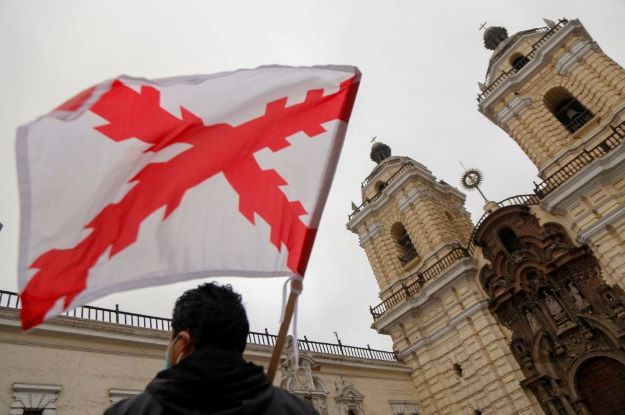Latin America
Related: About this forumWhat's With All the Imperial Spanish Flags in Peru (and Elsewhere)?
BY ANDREA MONCADA
OCTOBER 25, 2021
A nationalist turn among Peru’s right-wing parties — and some sectors of the population — points to increasing polarization.

A marcher carries the Cross of Burgundy flag in Lima on October 12.
Gian Masko/AFP via Getty
Since June, Peruvians have been witnessing an unusual sight in the streets of Lima. Groups of people have been spotted bearing a flag with a little-known symbol called the Cross of Burgundy — it made its first appearance during post-election rallies against purported election fraud by current President Pedro Castillo and his party, Perú Libre. More recently, on October 12, which is both Spain’s “Día de la Hispanidad” and Peru’s Indigenous Peoples and Intercultural Dialogue Day, the Peruvian Patriot Society (Sociedad Patriota del Perú) carried the flag in front of the statue of Christopher Columbus in Lima’s historical center. The group claimed to be protecting the statue from demonstrators against the legacy of colonialism and violence perpetrated during the Spanish conquest against indigenous populations.
The Cross of Burgundy — a symbol that pays homage to the Spanish monarchy and to the “civilizational crusade” it carried out in its former colonies — is not a common image in Peruvian society or politics. Its sudden appearance has raised many eyebrows, especially considering how the legacy of colonization has been newly questioned and criticized in many Latin American countries in the last few years, including Peru. In 2019, Mexican president Andrés Manuel López Obrador caused a stir by sending letters to King Felipe VI of Spain and Pope Francis asking them to apologize for the atrocities committed against indigenous peoples during the conquest of the Americas. And at his swearing-in ceremony in July, Pedro Castillo promised to “break with colonial symbols” and criticized Spain’s exploitation of Peru’s mineral resources during the colonial period — in front of Spain’s King Felipe VI, who had attended the ceremony.
The sudden appearance of this symbol is indicative of a change within Peru’s right-wing parties: They are adopting a nationalist discourse that emphasizes the country’s Spanish heritage, Catholicism, and ties to the Iberian Peninsula. The leader of the conservative Fuerza Popular party, Keiko Fujimori, recently participated in Viva 21, an event held by Spanish far-right party Vox with the purpose of “enriching Spanish culture.” Fujimori called the event a “symbol of Hispanic unity against the socialism of the 21st century” and said that she shared their defense of life and family. Three congressmembers of Avanza País, the party of conservative economist Hernando de Soto, have signed the Carta de Madrid, a document sponsored by Vox that claims to unite the “Iberosphere” against the global communist threat. Another group of parliamentarians from Renovación Popular (led by Rafael López Aliaga) also met with Vox representatives in Lima in September.
. . .
The apparent rise of nationalism in Peru is not an isolated occurrence in Latin America and is more easily understood as part of a wave of far-right sentiment in the region. Supporters of this tendency argue they are pushing back against the threats of communism and indigenismo. Many prominent political figures, including Eduardo Bolsonaro, son of Brazilian president Jair Bolsonaro; former Colombian presidents Andrés Pastrana and Álvaro Uribe; and Chilean politician José Antonio Kast, have participated in events held by Vox, an undoubtedly racist, nativist and xenophobic party which is currently undertaking an effort to unite the more conservative sectors of Latin America in an offensive against “globalism” and the left.
More:
https://www.americasqu.e/whats-with-all-the-imperial-spanish-flags-in-peru-and-elsewhere/